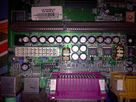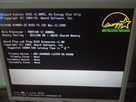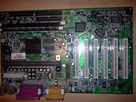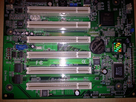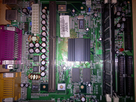When measuring voltages, put the black probe (negative probe) into the end of one of the black wires of an unused hard drive connector. You can also put it on the PSU casing or the case of the PC somewhere.
Then touch the red probe to whatever you need to measure. If you need to measure something in a tight space and you're worried about accidentally shorting 2 points together, then wrap the probe with tape so that only the tip is exposed.
Check voltages while the system is running, and pay attention to whether the voltages are stable or if they seem to fluctuate with load.
I'm assuming your PSU has a unified +12V rail, but if it has separate rails then they each should be checked. Some PSUs can have a separate +12V supply for the ATX connector vs the drive connectors (and another for the 4pin/8pin connector, which this board doesn't use).
PSU +5V can be checked using an unused 4pin drive connector. Red probe goes to the red wire. Black can go to any ground as mentioned above. It's more accurate to use the black ground wires on the same connector as what you're measuring, but that's not necessary.
PSU +12V is at the yellow wire of the same unused drive connector.
To measure battery voltage, just put the red probe on the top of the battery. It shouldn't be the problem here but might as well check it.
PSU +3.3V is at an orange wire on the ATX power connector. To measure that, you can push the red probe into the back of the connector, sliding it next to the orange wire until it makes contact with the metal connector inside of the plastic housing.
PSU +5Vsb (standby) is at the purple wire of the ATX power connector. It can be measured the same as the 3.3V (orange).
If you want to check more directly the +5V and +12V supplies that are going to the motherboard, you can measure at the red and yellow wires of the ATX connector this same way.
Between the peripheral ports and the CPU slot are a pair of MOSFETs labelled:
CET
CEB7030AL
These are used by the voltage regulator IC to produce Vcore.
They have 3 legs at one side and a large metal tab at the other.
Put the red probe at the large metal tab of one of them, and then the other.
One of these will give you the +5V supply that's providing power to the Vcore regulator.
The other will give you the Vcore output that's powering the CPU. It should be steady and matching what your CPU is supposed to have.
I noticed in your picture there's a marking that says "VDIMM" in the area between the CPU and the RAM, next to the RAM slots and close to an electrolytic cap.
It's very near a couple of tiny surface mounted caps. I wonder if one side of either of those caps would be the DIMM voltage.
On many SDRAM boards, the RAM runs directly from the +3.3V PSU supply, but maybe this one is fancier. Sometimes the chipset runs from that also, but I don't know what voltage the i810 uses.
There is a tolerance to all these values, but that tolerance includes high frequency ripple that you can't see with a multimeter because it happens too fast.
Personally, I also think many boards are not reliable when you get to the lower range of what is "supposed" to be allowed.
So in practice, it's good (and normal) to see voltages that are just a tiny bit higher than the specified value, and which don't sag more than a tiny bit when the system is under a heavy load.
Tested with P2 400 / P3 450 / P3 667. Best results with the P3 667.
Interesting, the P3-667 should have the lowest power consumption, but it's also running at a faster FSB clock.
So, i understand that the first step is to change capacitors. If i change it, do they have to be exactly the same ?
They should be "Low ESR" types, preferably made by either Nichicon, Nippon Chemicon, United Chemicon, Panasonic, Rubycon, Sanyo, NIC. If you have to take 2nd hand caps from other old boards (which is not ideal), then you might not have those choices. In that case, then Teapo is usually okay. *Not* Tayeh, which people sometimes confuse them with.
The capacitance value (uF) should be the same, slightly higher is okay. The Voltage rating can be the same or higher, higher won't hurt anything.
